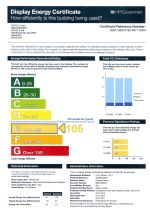
by Brianna Crandall — June 8, 2011— The Chartered Institution of Building Services Engineers (CIBSE) has published the results of a study of the first 45,000 DECs lodged on the Landmark register from October 2008 to mid-February 2010. The study focused on operational ratings, to assess the applicability of the CIBSE benchmarks and to recommend to the U.K. government any immediate changes needed to the benchmarks or allowances.
The detailed review by the UCL Energy Institute and the Usable Buildings Trust shows that the benchmarking system works well for those building categories most commonly found in the DEC database; 15,335 are schools, accounting for 52 percent of buildings with DECs, and the median school DEC Grade is within two percent of the benchmark. For offices with 3,230 buildings or 11 percent of the total, the median is almost exactly at the D/E boundary where it should be, said the researchers.
The benchmarks also work well for clinics, hospitals and emergency service buildings. In all, the researchers found a good correlation between actual operational ratings and the benchmark figures in 94 percent of the DECs included in the analysis.
The benchmarks for entertainment halls and theaters, dry sports and leisure facilities appear to be too generous, say the researchers. Benchmarks for laboratories and operating theaters and for workshops need some further review, in particular of their special energy uses, where electrical equipment has high load and may need to be added to the list of separable uses.
The CIBSE benchmarks group used the evidence from this analysis of DEC data and benchmarks to contribute to the U.K. Green Building Council report on the wider rollout of DECs to the private sector to promote energy efficiency in non-domestic buildings.




